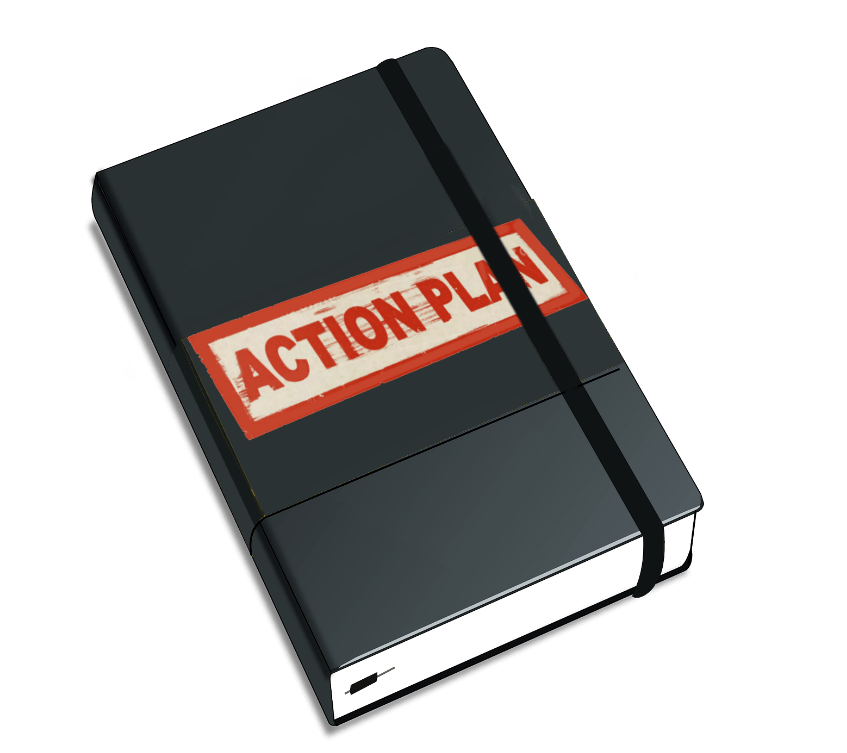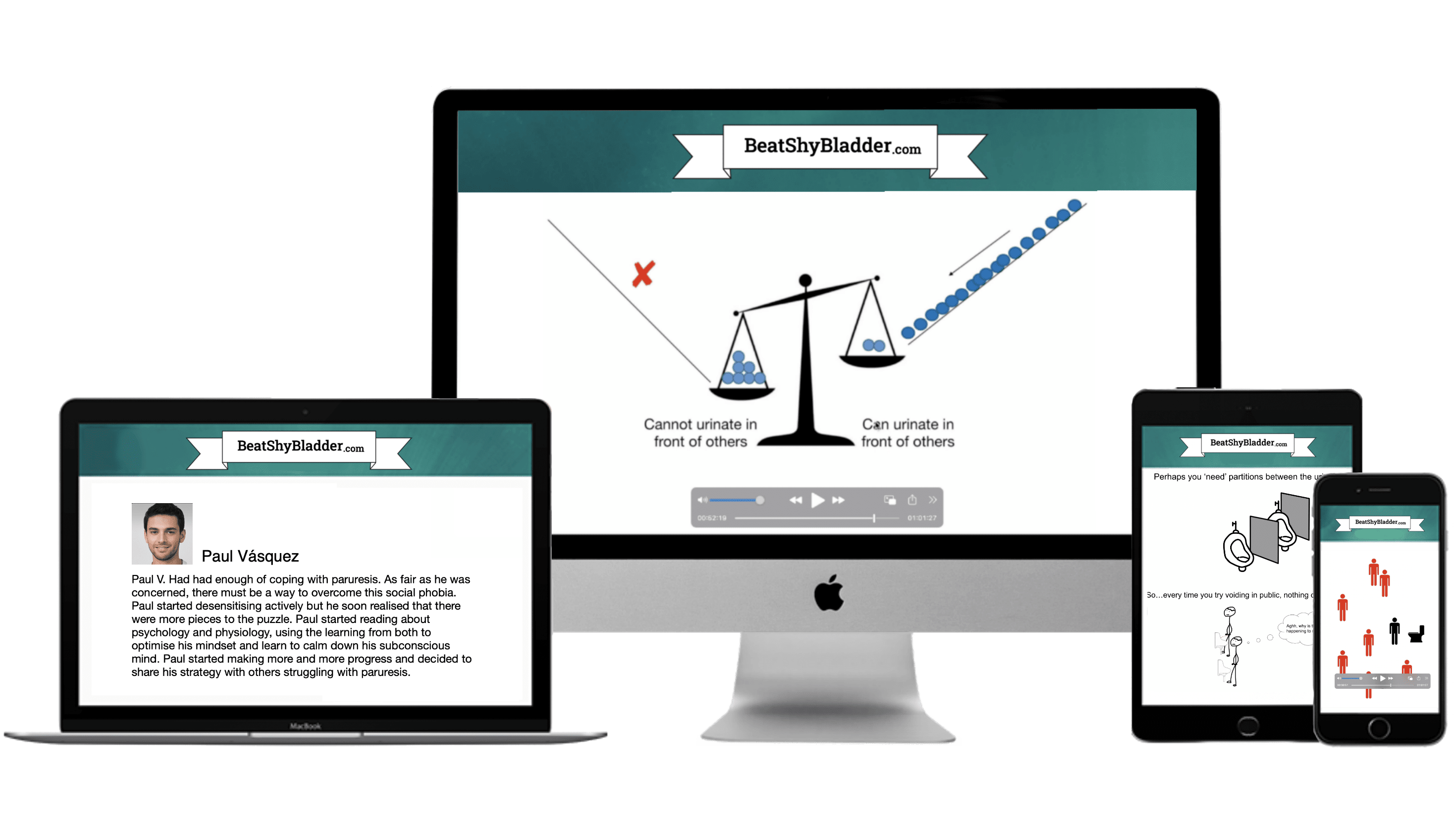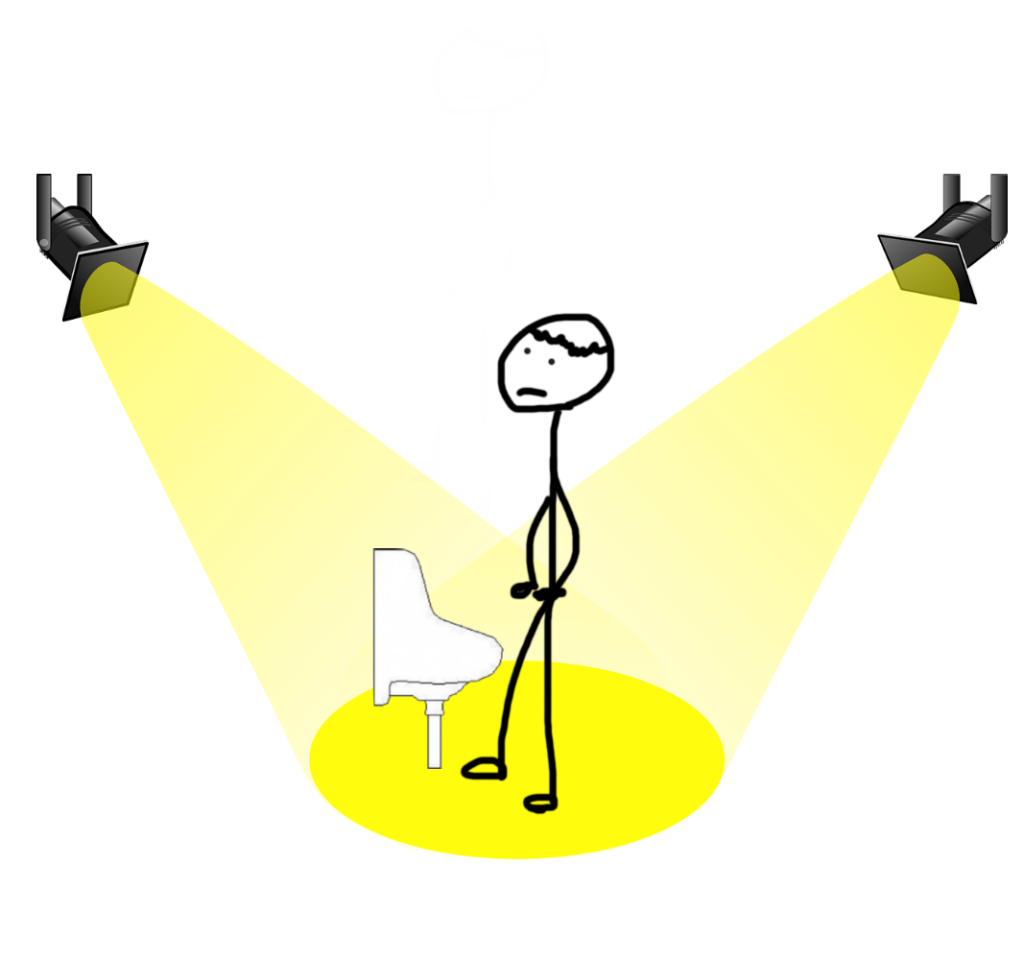Uh oh, nooo, not again!!
There I stood at the urinal trough in a jam-packed nightclub restroom back in my college years. I was a few drinks in and beyond desperate to void and get back to socialising and dancing with my friends.
Nope. Not a drop. I left the venue and made my way home early where I could void in peace. I vowed that would never happen to me again.
If you are reading this, chances are you know all too well that shy bladder syndrome can be a heavy burden. You may tired of the limitations associated with a shy bladder and determined to overcome this condition
So how can you treat shy bladder syndrome? Here is a step by step overview into how this can be done.
Step 1: Gain a sound understanding of the problem

It should be fairly obvious that if you don’t understand the root problem of paruresis, you can’t possibly know how to go about solving this anxiety.
Sure, on a high level we all know what the problem is (cannot void under certain circumstances – usually busy public restrooms or restrooms offering little to no privacy).
But what is the root problem? Understanding the feedback loop or anxiety cycle that underpins shy bladder, in my humble opinion, should be the first step in your road to recovery.
Think about it, the clearer your understanding of the root issue:
- The more obvious your coping mechanisms will become (your behaviours that reinforce paruresis)
- The more confidence you’ll have in the various treatment protocols and therefore, the more likely it is that you’ll consistently stick to your plan.
- When the problem is not well understood, ‘solutions’ only tend to create more problems.
To get an in-depth idea of what causes paruresis and why so many people struggle to make meaningful progress to overcome this condition, check out our blog post on ‘What causes shy bladder?’
Step 2: Develop a plan
Have you heard of the saying, ‘those who fail to plan, plan to fail’?
There is a fundamental truth to that statement because when people have no plan to follow and no north-star to shoot for, chances are they won’t stick to anything in the long term and won’t make any meaningful progress.

So how do you make a plan and what goes in it??? Here are a few components that can go into your plan:
2.1 Write down your ‘why’
As Simon Sinek says, ‘start with why’. This may appear to be a silly activity to some people but reflecting on why you even want to overcome paruresis in the first place and writing this down can make your determination to start taking action more palpable.
Here are some prompts you may want to think about:
- What does life look like for you right now?
- What impact is shy bladder having on you?
- How would things be different if you completely overcame paruresis?
- Why do you want to put the time and effort into overcoming this social phobia?
- What are you willing to do in order to achieve this?
There is no need to cope with a shy bladder when you can live without it. Writing down your ‘why’ is a good first step to take. As a side note, various psychology studies have shown that writing your goals down on paper increases the likelihood you’ll actually achieve them.
2.2 Note down your coping mechanisms
Write down all of your coping mechanisms. A coping mechanism is a behaviour that people carry out in order to accommodate for their paruresis.
In other words, all the behavioural differences between the current version of you and the version of yourself that doesn’t have paruresis.
Here are a few common examples to get your mind thinking:
- Holding it in for hours and refusing to attempt passing urine until you find a ‘safe’ restroom.
- Only using noisy restrooms
- Putting paper down the toilet to muffle the noise (more common amongst women)
- Waiting for friends to have gone
- Minimising fluid intake
- Not going to social venues
These are the behaviours that are reinforcing your shy bladder on a subconscious level. As far as your subconscious threat detection mechanism is concerned, if you are engaging in coping mechanisms, there is something to fear. If you think about it, the difference between someone with paruresis and someone without it, is that the person without is does not have coping mechanisms.
2.3 Write down your hierarchy
While some people may struggle to void anywhere outside of their own home, others may only experience bladder-lock in very confined and crowded public spaces.
Write down where it is that you have no problems voiding, the scenario that would be most difficult to pass urine in and a few steps in between.
Here’s another way to think about this. If your shy bladder syndrome was weaker by increments of 10% up until not having it at all, what would be the scenarios that you would be comfortable voiding in at each of those 10% increments.
2.4 Choose your treatment protocols
At the most fundamental level, in order to treat paruresis, you must simply stop engaging in your coping mechanisms. Now that you have identified them, you can start to cut down on them.
Other than cutting down on your coping mechanisms, there are a few interventions that may work well for you. Here is some of them:
Exposure Therapy
The most established way of overcoming a shy bladder is ‘systematic desensitisation’. In fact, this practice is commonly used for people to overcome a wide variety of different phobias. From approach anxiety to OCD, systematic desensitisation or ‘gradual exposure therapy’ can produce great results.
This is where you begin to constantly expose yourself to the scenarios you wrote down in the hierarchy. Over time, you’ll become more relaxed in each of those environments.
Neurofeedback
Neurofeedback, also known as EEG biofeedback, is a type of therapy that uses real-time displays of brain activity to help individuals improve their mental health and well-being. The goal of neurofeedback is to train the brain to function more efficiently, which can result in improvements in a wide range of mental and physical health conditions.
The idea behind using neurofeedback for paruresis is that by providing individuals with information about their own brain activity, they can learn to modify their thoughts and behaviors in real-time, which can help reduce their anxiety and improve their ability to use public restrooms.
Cognitive Behavioural Therapy
You could argue that exposure therapy falls under CBT however, there are other practices under CBT that can help dissect faulty beliefs contributing towards paruresis. These excercises may include determining limiting beliefs or negative thoughts and questioning their validity
Mindful meditation
Will meditation in and of itself treat your shy bladder? Probably not.
But can it be an effective practice to compliment exposure therapy? Absolutely.
Meditation has shown time and time again to be a effective way to calm the mind, reduce the automatic fear response and even decreases the physical size of the amygdala (the part of the brain that triggers the fight or flight response).
2.5 Create a tracking sheet
You want to measure and celebrate success as well as be made aware if a certain intervention is producing no results. This information will provide feedback you can use course-correct.
Create a spreadsheet where you can track how often you are practicing exposure therapy, meditation etc. This can also help you identify how often your coping mechanisms are creeping in and slowing down progress.
Step 3: Get in the right the mindset
Paruresis has little to nothing to do with physical handicaps or deficiencies. Instead, shy bladder is the result of faulty mental programming. It would therefore make sense that your mindset will have a large influence on how you make progress.
There are certain key mindset shifts people often have to make to make things more productive. Here are a selection of the mindset sifts discussed within the blueprint:
- Responsibility: We talk about the importance of taking ownership and responsibility in this blog post.
- Perception of ‘misfires’: A mindset that is helpful to many people is that when beginning this journey towards recovery, the initial goal is not to start voiding in crowded venues. The goal is to start attempting to void in places that cause you discomfort. ‘Misfires’ (when you can’t void due to shy bladder) are therefore not only to be expected but they are actually a good sign that you are stepping outside of your comfort zone instead of letting your coping mechanisms prevent you from making progress.
- Static versus growth mindset: Realise that you CAN make significant progress. Make sure your internal dialogue reflects this potential. Far too often, people engage in destructive self talk by saying or thinking things like “I’ll have a shy bladder for ever”. By reframing your thoughts to “I sometimes experience stage fright”, you are segregating the shy bladder from your identity and therefore, allowing yourself to take the action necessary to actually overcome this condition. Lose any hard beliefs that say “I can’t…” and reframe them.
- Progress mindset: Look to achieve progress, not perfection.
- Expectations: Overcoming shy bladder syndrome is very doable however, it will take time and effort. Unfortunately, the is no magic cure.
Overcome Shy Bladder Syndrome Today
Get your hands on the time tested Beat Shy Bladder Blueprint
- Self Auditing
- Protocol Reviews
- Knowledge Trove
- Feedback Loops
- Heart Rate Variability
- Visualisation
- Mindset Upgrade
- Desensitisation




